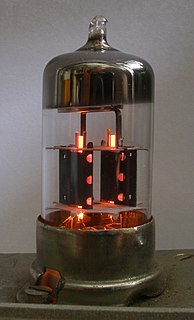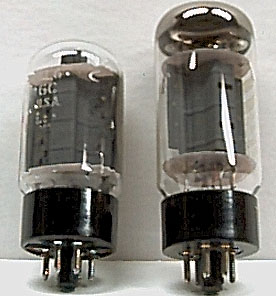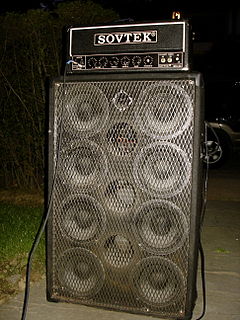
A triode is an electronic amplifying vacuum tube consisting of three electrodes inside an evacuated glass envelope: a heated filament or cathode, a grid, and a plate (anode). Developed from Lee De Forest's 1906 Audion, a partial vacuum tube that added a grid electrode to the thermionic diode, the triode was the first practical electronic amplifier and the ancestor of other types of vacuum tubes such as the tetrode and pentode. Its invention founded the electronics age, making possible amplified radio technology and long-distance telephony. Triodes were widely used in consumer electronics devices such as radios and televisions until the 1970s, when transistors replaced them. Today, their main remaining use is in high-power RF amplifiers in radio transmitters and industrial RF heating devices. In recent years there has been a resurgence in demand for low power triodes due to renewed interest in tube-type audio systems by audiophiles who prefer the sound of tube-based electronics.
A tetrode is a vacuum tube having four active electrodes. The four electrodes in order from the centre are: a thermionic cathode, first and second grids and a plate. There are several varieties of tetrodes, the most common being the screen-grid tube and the beam tetrode. In screen-grid tubes and beam tetrodes, the first grid is the control grid and the second grid is the screen grid. In other tetrodes one of the grids is a control grid, while the other may have a variety of functions.

A valve amplifier or tube amplifier is a type of electronic amplifier that uses vacuum tubes to increase the amplitude or power of a signal. Low to medium power valve amplifiers for frequencies below the microwaves were largely replaced by solid state amplifiers during the 1960s and 1970s. Valve amplifiers are used for applications such as guitar amplifiers, satellite transponders such as DirecTV and GPS, audiophile stereo amplifiers, military applications and very high power radio and UHF television transmitters.

12AX7 is a vacuum tube that is a miniature dual triode - 6AV6 with high voltage gain. It was developed around 1946 by RCA engineers in Camden, New Jersey, under developmental number A-4522. It was released for public sale under the 12AX7 identifier on September 15, 1947. The 12AX7 was originally intended as replacement for the 6SL7 family of dual-triode amplifier tubes for audio applications. It is popular with tube amplifier enthusiasts, and its ongoing use in such equipment makes it one of the few small-signal vacuum tubes in continuous production since it was introduced.

KT66 is the designator for a beam tetrode vacuum tube introduced by Marconi-Osram Valve Co. Ltd. (M-OV) of Britain in 1937.

6L6 is the designator for a vacuum tube introduced by Radio Corporation of America in July 1936. At the time Philips had already developed and patented power pentode designs, which were rapidly replacing power triodes due to their greater efficiency. The beam tetrode design of the 6L6 allowed RCA to circumvent Philips' pentode patent.

A plate, usually called anode in Britain, is a type of electrode that forms part of a vacuum tube. It is usually made of sheet metal, connected to a wire which passes through the glass envelope of the tube to a terminal in the base of the tube, where it is connected to the external circuit. The plate is given a positive potential, and its function is to attract and capture the electrons emitted by the cathode. Although it is sometimes a flat plate, it is more often in the shape of a cylinder or flat open-ended box surrounding the other electrodes.

A pentode is an electronic device having five active electrodes. The term most commonly applies to a three-grid amplifying vacuum tube, which was invented by Gilles Holst and Bernhard D.H. Tellegen in 1926. The pentode consists of an evacuated glass envelope containing five electrodes in this order: a cathode heated by a filament, a control grid, a screen grid, a suppressor grid, and a plate (anode). The pentode was developed from the tetrode tube by the addition of a third grid, the suppressor grid. This served to prevent secondary emission electrons emitted by the plate from reaching the screen grid, which caused instability and parasitic oscillations in the tetrode. The pentode is closely related to the beam tetrode. Pentodes were widely used in industrial and consumer electronic equipment such as radios and televisions until the 1960s, when they were replaced by transistors. Their main use now is in high power industrial applications such as radio transmitters. The obsolete consumer tubes are still used in a few legacy and specialty vacuum tube audio devices.

Sovtek is a brand of vacuum tube owned by Mike Matthews's New Sensor Corporation and manufactured in Saratov, Russia. They are often used in guitar amplification and include versions of the popular 12AX7, EL84, EL34, and 6L6. Many of the vacuum-tube amplifiers in modern production are factory-fitted with Sovtek valves. Originally, Sovtek guitar amplifier valves were claimed to have been descendants of earlier wartime Russian-made components and carried blast proof capabilities. This, however, was later dispelled as urban myth, attributed to a sales person who promoted early product at music industry trade shows worldwide.

A single-ended triode (SET) is a vacuum tube electronic amplifier that uses a single triode to produce an output, in contrast to a push-pull amplifier which uses a pair of devices with antiphase inputs to generate an output with the wanted signals added and the distortion components subtracted. Single-ended amplifiers normally operate in Class A; push-pull amplifiers can also operate in Classes AB or B without excessive net distortion, due to cancellation.
Ultra-linear electronic circuits are those used to couple a tetrode or pentode vacuum-tube to a load.

Tung-Sol was an American manufacturer of electronics, mainly lamps and vacuum tubes.
M-OV was a British manufacturer of thermionic valves. It was a subsidiary of the (British) General Electric Company Ltd.
JJ Electronic, s.r.o is one of the world's remaining producers of vacuum tubes. They are based in Čadca, in the Kysuce region of Slovakia. Most of the products that JJ offers are audio preamplifier tubes, and tubes for audio power amplifiers. These vacuum tubes are mainly used for guitar and hi-fi amplifiers. Technically, the vacuum tubes produced by JJ Electronic are mainly low-noise triodes, beam tetrodes and power pentodes. Double diode vacuum tubes for AC-to-DC rectifiers are also produced. JJ also produces electrolytic capacitors for higher voltage purposes, generally for use in audio amplifiers. JJ also manufactures their own line of high-end audio amplifiers and guitar amplifiers. In 2015, the company sales amounted to EUR 8.5 million and net income came to EUR 3.8 million. Most of the products are exported to the United States.














